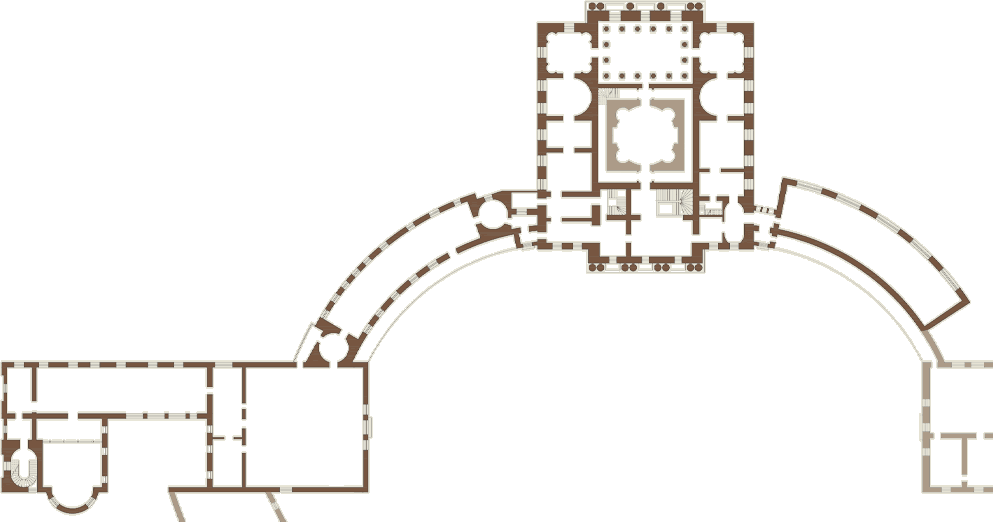The Maid of Honour's Room
Загрузка панорамы...
The room was intended for the court ladies waiting for the Empress to come out. It was created in 1797–1799 per the project of Vincenzo Brenna on the site of the former study of Maria Feodorovna and part of her Dressing Room. The appearance of the Maid of Honour's Room, consisting of two rectangular rooms, was due to the expansion of the palace, and it became the place of transition from the central halls to the state halls of the new Southern Building. The walls were divided into panels and decorated with artificial marble and stucco. Originally, there was a mahogany piano, two similar tables, a steel table with a painting on the top, two chests of drawers, and eleven chairs painted white and upholstered in green morocco.
On the walls are paintings by French artists of the 18th century. Between the windows is the Portrait of the Grand Duchess Maria Feodorovna (Jean-Louis Voille, 1792), on the opposite wall is the Cupid Shooting with a Bow (Charles-André van Loo, 1761), and on its sides are the Women's Heads by Jean-Baptiste Greuze, in whose workshop the owners of Pavlovsk purchased several paintings. In the part of the Maid of Honour's Room adjacent to the Upper Vestibule there are paintings by Hubert Robert: Apollo Hall and Laocoon Hall (the 1800s), acquired by Maria Feodorovna in 1806, as well as Fantastic Landscape with a Statue of Marcus Aurelius" (the 1780s), Park with Ruins and Landscape with a Round Temple on a Mountain" (the 1770s) (on the sides of the door to the Upper Vestibule).
The furniture of the room consists of various items of cabinet furniture and furniture for sitting. Sofas and armchairs are made of carved gilded wood: a characteristic example of the furniture of the late 18th century. Under the portrait of Maria Feodorovna is a cylindrical mahogany bureau (Germany, David Roentgen, the 1780s), on which there is a French gilded bronze clock made of 18th century with a scene from The Deserter, the popular opera of the time by the composer Pierre‑Alexandre Monsigny (Paris, workshop of Jean-Baptiste Goyet). A music box for the clock of Russian work performs several melodies from the opera. Near the wall next to the Dressing Room there is a marquetry cabinet (France, workshop of Jacques Dautriche, the 18th century), on which the clock Allegory of Sciences is placed (Paris, clockmaker John Baptiste Baillon III, the 1760s). In another part of the Maid of Honour's Room, near the window, you can see a unique ebony escritoire of Russian work (St. Petersburg, Jonathan Ott's workshop) with inserts in the eglomise technique. Dark silhouettes images of members of the grand ducal family can be seen on a golden mirror background: on the doors are the figures of Pavel Petrovich and Maria Feodorovna, sons Alexander and Konstantin in the garden; on the drawers are the silhouette heads of daughters Alexandra, Elena, Maria, and Catherine. On the bureau, there is a set of gilded and patinated bronze: a clock and two vases (France, the 18th century). On the sides of the door leading to the Upper State Vestibule are two paired chests of drawers (Russia, the 18th century), on which bronze candelabra are placed (France, sculptor Louis Simon Boizot, the workshop of Pierre Gouthière, the 1770s). There is a marble sculpture in the niche: Vestal, by Louis Simon Boizot, 1769.
The Maid of Honour's Room on the floor plane
- The Egyptian Vestibule
- The Carpet Study
- The Second Interconnecting Study
- The Main Staircase
- The Hall of War
- The Picture Gallery
- The Upper Vestibule
- The Greek Hall
- The Third Interconnecting Study
- The Italian Hall
- The Hall of Peace
- The Throne Room
- The Valet de Chambre Room of Paul I
- The Library of Empress Maria Feodorovna
- The Pantry
- The Dressing Room of Paul I
- The Boudoir
- The Orchestral Room
- The Rossi Study
- The State Bedroom
- The Knights Room
- The Rossi Library
- The Dressing Room of Maria Feodorovna
- The Chevalier Guard Room
- The Small Study of Emperor Paul I
- The Maid of Honour's Room
- The Anteroom (Turkish Room)
- The State Library of Paul I
- The First Interconnecting Study
- The Palace Church

Back
